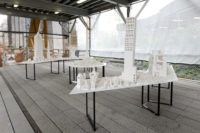On June 5, ten years after New York’s High Line Park opened and took the world by storm, its final segment is now complete. The Spur, designed by the original High Line team led by landscape architect James Corner Field Operations with architect Diller, Scofidio + Renfro, transforms a half-block-long extension of the once-abandoned railroad trestle. The entire 1.4-mile park, with its elevated vistas of the surrounding city, draws millions of visitors every year to the improbable wild garden planted on the old viaduct.
The Spur hugs the southern edge of the Hudson Yards megadevelopment on Manhattan’s West Side at West 30th Street and Tenth Avenue. It pulls away from the main viaduct to run through massive piers holding up the 10 Hudson Yards office tower (designed by KPF). Between the piers of the shadowy 60-foot-tall passage, delicate wood-floored balconies project over the sidewalk below, offering kaleidoscopic views of the surroundings and a look back along the original High Line.
The passage through the piers culminates in a mass of trees planted on a steeply sloped hillock. As it continues, it slices through the hillock, walled by thick sheets of weathering steel and directs the visitor toward “Brick House” by Simone Leigh, a monumental bronze bust of an African-American woman. Sitting in a surprisingly welcome open plaza, she presides above the traffic-clogged cacophony of 10th Avenue in an attitude of world-weary calm, though her face is evocatively blank where eyes would be. It is the inaugural commission for a series of temporary installations organized by the nonprofit Friends of the High Line, the organization that helps the City operate the park.
Because of the narrowness of the viaduct, “The Spur offers a space to host activities and events,” says DS+R partner Ricardo Scofidio. “We were able to build the largest planters, add the most seating, and accommodate the largest artwork there,” he adds. Both loose chairs and built-in benches of recycled teak add to the casual, comfortable ambience.
Not coincidentally, the openness and calm contrasts with the older park that increasingly resembles the crowded streets below with its hordes of amiably meandering visitors and the many looming buildings—some by celebrity architects, including Zaha Hadid, Neil Denari, and BIG—that have risen along its east and west edges.







Post a comment to this article
Report Abusive Comment